The best carbon gravel bikes offer a range of ride options to suit your style and budget. There’s a huge range to choose from, with no brand’s range complete until it has a gravel bike. Many bike makers have two or three different gravel platforms to cater for different gravel riding styles.
The ability to deliver flex where it’s needed and stiffness where it can aid pedalling efficiency means carbon fibre is an ideal material from which to construct gravel bikes. Carbon fibre can also reduce vibration transmitted to the rider and micro-suspension elements can be built into the carbon layup to further aid comfort.
Below is quite a long list of the best carbon road bikes, all rated and reviewed by our expert testers, who between them have clocked up thousands of riding hours and have years of experience.
You can skip to the end to read our buyer’s guide to the different types of carbon gravel bikes and how carbon gravel bikes compare to the best gravel bikes made from other frame materials.
Best carbon gravel bikes in 2024
Boardman ADV 9.0
- £1,800 as tested
- Pros: Excellent value; great ride quality; low weight is impressive for the price
- Cons: Sharp edges on stem
The value for money offered by the Boardman ADV 9.0 is exceptional and made it the winner of BikeRadar’s Bike of the Year Best Value award in 2021. It’s a sub-£2,000 gravel bike that can go anywhere and is very light for its price, stiff and responsive. This leads to great off-road riding and fast acceleration in tarmac.
Boardman is good at spending its money where it will make a difference, so you get a canny mix of Shimano GRX components with a good gear range and tubeless-ready wheels. They’re shod with Panaracer GravelKing SK gravel tyres, which are grippy off-road but roll fast as well.
Canyon Grail CFR Di2

- £6,699 / €6,999 / AU$10,599 as tested
- Pros: Calm and stable; integrated storage; adaptable; great build
- Cons: Fragile tyres; proprietary mudguard mounts
The latest Canyon Grail launched in October 2023 in its new gravel-racing guise.
Deputy editor Jack Luke awarded the Shimano GRX Di2-equipped model a full five stars, praising its go-fast potential, composed ride and superb geometry.
The integrated down tube storage and the inclusion of a frame bag make this bike an appealing pick. However, the cheaper CF SLX 8 Di2 model is arguably just as good, even if it’s a smidge heavier.
It may be a gravel race bike, but the quick-release mudguards cement the Grail’s versatility. It’s just a shame you can’t fit standard fenders.
Canyon Grizl CF SL 8 1by

- £2,949 / $2,849 / €2,699 / AU$4,249 as tested
- Pros: Versatile carbon frameset; great spec; well thought-out geometry
- Cons: 1x gearing might not be low enough for some; Canyon-specific mudguard mounts
Canyon has two gravel bikes in its quiver, the fast Grail and the more hardcore gravel Grizl, which enables you to fit 50mm tyres. The Grizl also comes with a longer, slacker geometry than the Grail and all the mounting points needed for gravel adventures.
As usual with Canyon bikes, there’s a quality spec at a competitive price, with a 1x Shimano GRX groupset, DT Swiss gravel wheels and Canyon VCLS bump-absorbing seatpost.
It’s a bike that handles typical UK off-road conditions really competently and also progresses well on tarmac.
The mudguard mounts are Canyon-specific.
Cannondale Topstone Carbon Lefty 1

- £7,500 / $8,500 / €8,399 as tested
- Pros: Handling, control and speed are top-notch; comfortable on terrain suited to mountain bikes
- Cons: High price
All Cannondale Topstone Carbon gravel bike models come with 30mm of vertical travel at the rear. The Lefty models add another 30mm at the front as well, courtesy of Cannondale’s single-legged Lefty Oliver carbon suspension fork.
Unridden, it looks a bit strange, but sit a rider on it and the sag in the suspension gives the bike a more usual gravel bike geometry. However, the stability means the bike is great on more technical terrain and helps it fly over flatter gravel trails, making it one of the most capable gravel bikes we’ve ever reviewed.
The Topstone Lefty 1 is well kitted out too, with a SRAM AXS single-ring groupset and carbon wheels, with plenty of clearance and 700c or 650b wheels an option.
Devinci Hatchet Carbon GRX LTD

- $3,299 / CAD$3,999 / €3,499 as tested
- Pros: Superbly stable yet fun handling; something a little different
- Cons: No higher spec available
The Devinci Hatchet has a long and slack MTB-like geometry and comes competitively specced, with a gravel dropper post included. The bike can take 700c or 650b wheels with plenty of tyre clearance: 50mm tyres with 700c wheels, which heads up to 53mm on 650b wheels.
That all adds up to a great ride that’s fast and fun on everything from regular gravel to deep sand and mud. Although this build is specced with Shimano GRX RX600, there’s now an RX810 spec that sits above it.
Fara F/All-Road

- £4,620 as tested
- Pros: Nimble handling; value-packed
- Cons: Not suitable for more technical terrain
Norwegian brand Fara specialises in direct-to-market bikes, with its F/All-Road targeting road rides with some gravel rather than vice versa, with 38mm tyre clearance. It’s a type of riding typical in Norway and the Fara F/All-Road delivers versatility, handing and value for money.
The finish of the sub-kilo frame is exceptional and there are no fewer than four bottle mounts, as well as fork and mudguard mounts. It’s well-specced too with a 2x SRAM Force AXS groupset that goes below 1:1, a 3T cockpit, carbon Fulcrum wheels and Panaracer GravelKing Light TLR 35mm tyres.
The ride is quick and responsive on-road and fast, and nimble on unmetalled surfaces, although it’s not a bike for more technical terrain.
Giant Revolt Advanced Pro 0
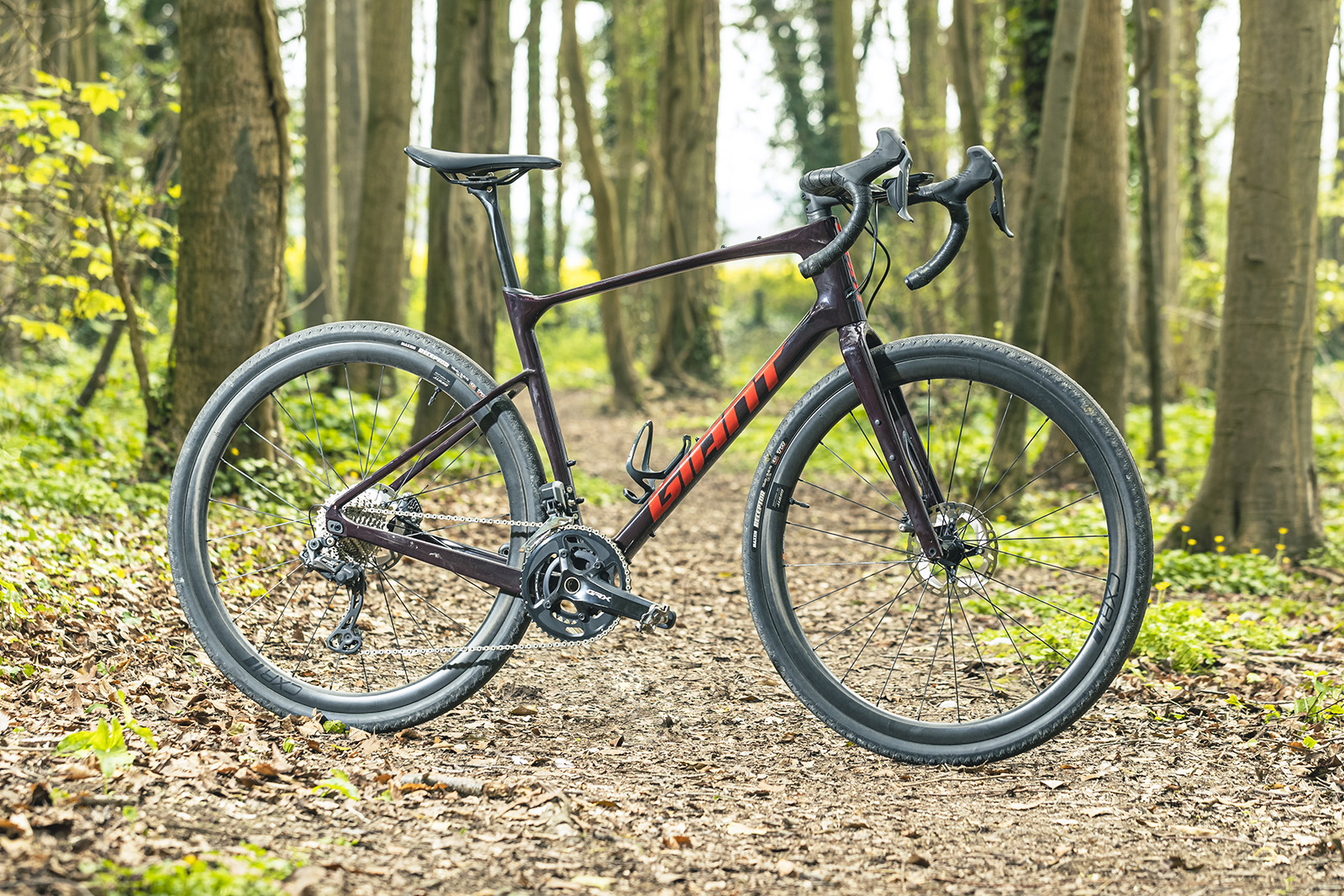
- £4,999 / $6,400 / €5,599 / AU$6,699 as tested
- Pros: Thrilling and plush ride; great groupset; fast wheels
- Cons: Tyres aren’t suitable for wet conditions
The Giant Revolt Advanced Pro 0 won our Bike of the Year competition in 2022 and was the first gravel bike to win overall. With an 8.3kg weight, we rated the fast geometry and lightweight gravel-specific CRX wheelset.
There’s tyre clearance of 53mm at the fork for a plush ride. Along with a GRX RX810 Di2 groupset, it makes for great performance. It’s a bike with all the mounts for a bikepacking trip, as well as being great for shorter, faster rides.
Giant Revolt X Advanced Pro 1

- £5,500 / $6,200 / €6,000 as tested
- Pros: Burly suspension; spec; tweaked geometry for tougher terrain; quality wheels and mullet drivetrain
- Cons: Dropper post can be bouncy
Adding an X to its name, the Giant Revolt X Advanced Pro 1 also gets a RockShox Rudy XPLR Ultimate 40mm-travel suspension fork, along with chunkier tyres and a tweaked geometry. The dropper post also works as a suspension seatpost with 25mm travel when fully extended.
This transforms the bike from a gravel all-rounder to something geared to more difficult terrain. There’s a flippable rear dropout that enables you to fit either 45mm or 53mm tyres, and you can even mount a couple of water bottles on the top tube for a total of five.
Giant specs its own carbon hookless bead CXR 1 wheels with a claimed weight of under 1,400g and 54 points of engagement from DT Swiss internals. There is a mullet drivetrain made up of Rival/GX Eagle AXS components that gives lots of low-speed grunt with a 40x52t lowest ratio.
Liv Devote Advanced Pro

- £4,699 / $5,500 / €5,000 / AU$7,299 as tested
- Pros: Women’s-specific geometry; dropper seatpost compatibility
- Cons: Tyres are sketchy in the wet
The Liv Devote Advanced Pro comes from Giant’s women’s brand and shares many of the features of the Revolt Advanced Pro above. Sizing, geometry and component choice are attuned to women’s needs though.
Despite the 30.9mm diameter of the carbon seatpost, it’s effective at damping the ride at the saddle. The wider diameter also means you can swap it out easily for a dropper post. There’s a wide gear range from the SRAM Force AXS groupset and all the mounts you’ll need, whatever the use you put the Devote to.
Orbea Terra M21e Team 1X

- £5,358 / $5,874 / €5,364 as tested
- Pros: Compliant and comfortable ride; fast
- Cons: Solid wheels
Orbea was early to the gravel scene, releasing the original Terra in 2017. This latest version of the Orbea Terra delivers everything an all-round modern gravel bike should.
It’s versatile with enough mounts for bikepacking, quick and comfortable enough for gravel racing, and has the geometry for more technical, singletrack riding.
Costing £5,358/$5,874 with a SRAM Force AXS XPLR 1x drivetrain, the Terra represents good value for money compared to bikes such as the Specialized Crux Expert and Giant Revolt X.
The one downside to this carbon gravel bike is the Fulcrum wheels. It would be nicer to have a lighter, faster set of gravel wheels. But really, this is a small criticism of an otherwise excellent bike.
Trek Checkpoint SL6 eTap
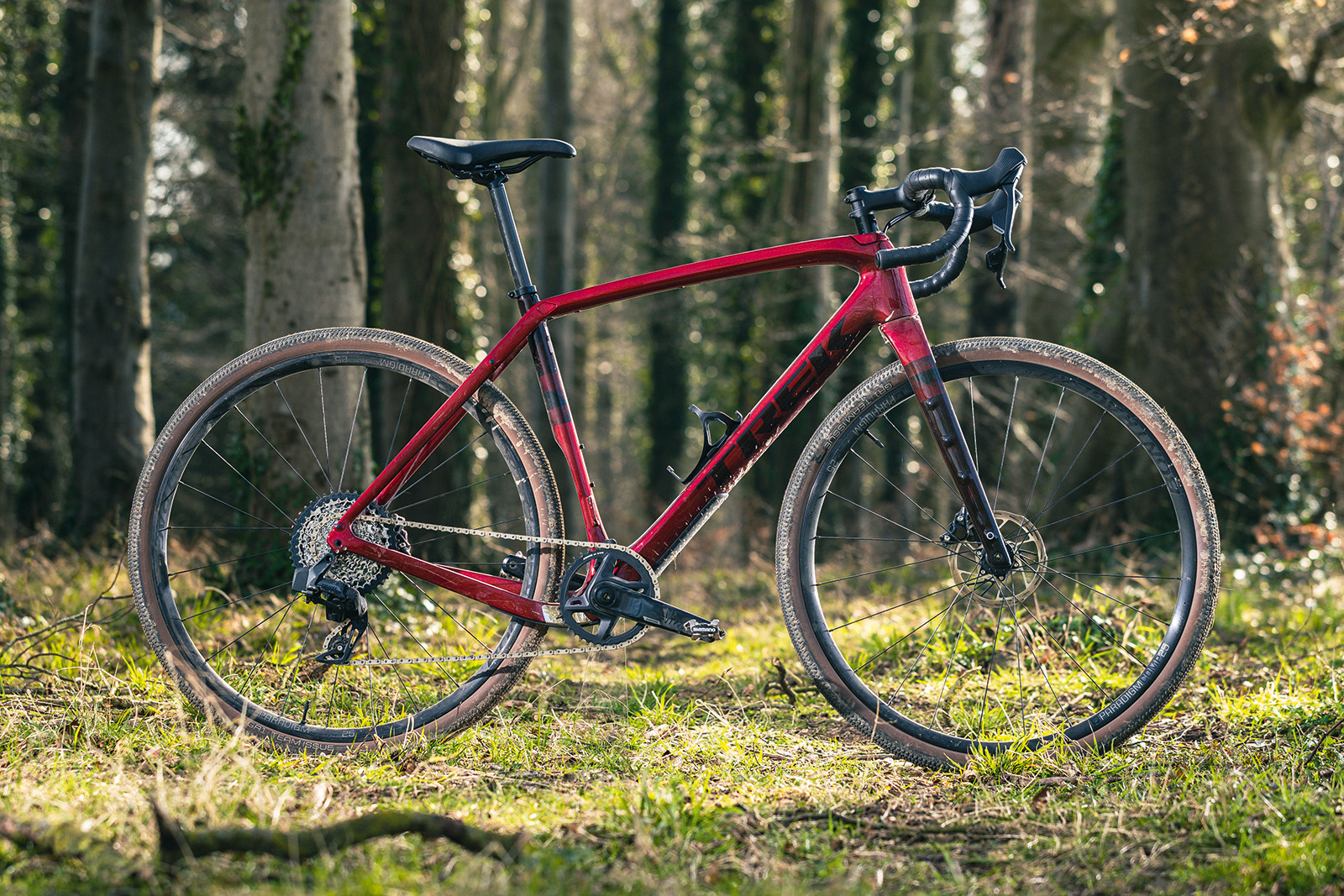
- £3,850 / $4,300 / €4,300 / AU$5,500 as tested
- Pros: Comfy and fairly fast; mounting options; excellent handlebars
- Cons: Inelegant seatpost design; can be rattly
The Trek Checkpoint SL6 comes with Trek’s IsoSpeed decoupler for added compliance. It works well, particularly over big hits, to make things more comfortable at the saddle.
Despite its 9.5kg weight, the Checkpoint feels fast on fire roads and on tarmac.
There’s 45mm tyre clearance with 700c wheels and 2.1in with 650b, so there are plenty of options to fit big tyres to help smooth things out and add a little more grip.
Our test bike was equipped with a SRAM Rival AXS XPLR single-ring groupset, giving a good range in a simple-to-use configuration.
You even get Trek’s storage compartment in the down tube for tools, tubes and extras.
Lauf Seigla Weekend Warrior
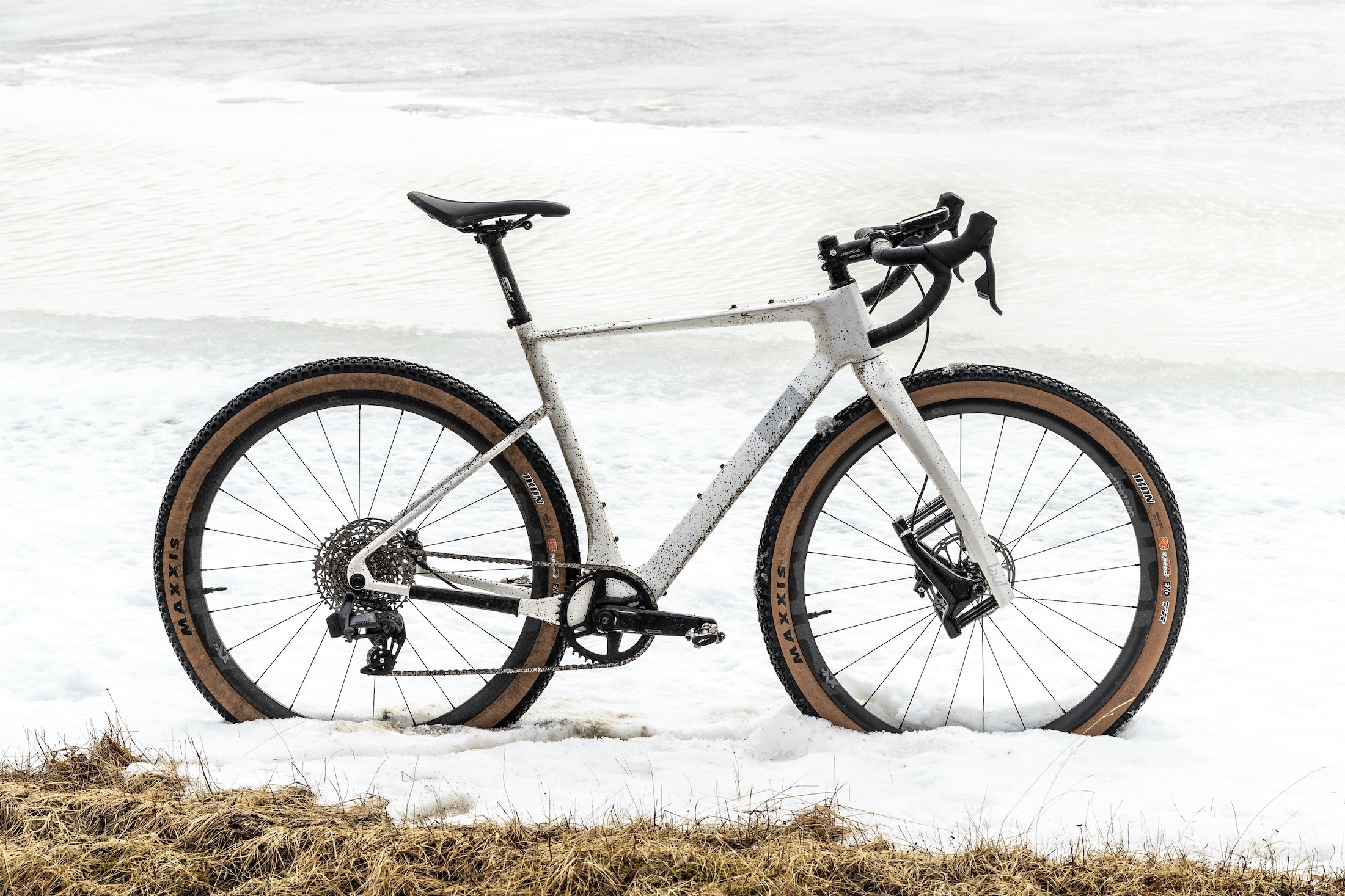
- £3,890 as tested
- Pros: Inspired geometry; grit fork smooths surfaces; wide tyre clearance up to 29×2.25 in
- Cons: Limited dropper post options; wide bottom bracket; fork chassis can twist
Icelandic brand Lauf is best known for its Grit leaf spring suspension fork, but it also has an increasing range of gravel bikes to mount it to. The Lauf Seigla increases tyre clearance over its previous models and also adds compliance with features such as dropped seatstays and a tapered top tube.
The Grit fork is in its third generation and, although there’s a little bob when climbing, damping is exceptional. When going down the other side, the fork handles larger hits and leads to composed descending.
The Seigla can only fit a 1x drivetrain and the test bike was equipped with SRAM Rival AXS XPLR. The wide BSA73 bottom bracket also means there are a limited number of cranksets available to fit.
Vielo V 1 Strato SRAM Rival AXS XPLR

- £5,299 as tested
- Pros: Lovely aesthetics and construction; boutique gravel racer
- Cons: Saddle clamp slips
Vielo’s V 1 Strato SRAM Rival AXS XPLR looks fantastically clean, thanks to the 1x only frameset and classic lines. Its geometry is very much like a road bike and the frame weighs around a 1kg, confirming its fast gravel leanings.
There’s still the option to fit 50mm tyres and either 700c or 650b wheels though, which can add a little extra comfort over rougher territory. Vielo says the frame has added compliance built into its carbon layup around the seatstays and chainstays.
Although badged Rival, there’s a mix of Rival, Force and own-brand components fitted, with gearing down to 1:1.
Vitus Venon EVO-GR Rival AXS 1X

- £3,500 / $4,099 / €3,900 / AU$6,300 as tested
- Pros: Road and off-road ready; fast; forgiving ride
- Cons: Not suitable for singletrack
The Vitus Venon EVO can be built as a gravel or road bike, with the road version winning our 2023 Bike of the Year award.
Vitus has done a fine job of avoiding any pitfalls that may arise from designing a frameset that’s intended to be used as an endurance road bike and gravel bike. This gravel-specific version challenges racy gravel bikes such as the Cervélo Aspero and Specialized Crux.
Unsurprisingly, it’s not so suited to tricky off-road terrain, but in this build, you’re getting a highly capable and value-packed bike. It could also serve road duties with a change of wheels and tyres.
3T Exploro RaceMax

- £3,849 as tested
- Pros: Tons of versatility; aero design; clever all-rounder
- Cons: Not the best value
The 3T Exploro range has expanded from the one original frame design, with the RaceMax – as its name suggests – the fast option.
Like all Exploros, it’s aero-optimised – an oddity for a gravel bike when it was introduced, but now increasingly a feature of the best gravel race bikes.
Also novel at the time was the option to fit a 1x or 2x drivetrain and the ability to use 650b wheels, with the Exploro RaceMax handling rubber up to 57mm on 650b wheels.
It’s stiff and responsive, with balanced handling and great versatility. But coming from a niche brand, it’s not the best value-for-money option. There’s a version with a motor if you want an electric gravel bike.
Basso Palta Disc Ekar

- £5,199 / $7,560 / €5,164 as tested
- Pros: Superb frameset; sensible price; great all-road performance
- Cons: Skinny tyres; geometry not suited to technical terrain
The Basso Palta Ekar is firmly in the go-fast gravel camp, with aero-optimised tubes and a slender fork. The frameset, which is made in Italy, is also lightweight. Our XL-sized test bike tipped the scales at 8.67kg.
The bike is suited to all-road style riding. The geometry is similar to an endurance road bike, but slightly longer and lower, creating a fast ride. The flispide to this is the Palta isn’t so suitable for more technical off-road terrain.
FThe Palta comes with a Campagnolo Ekar groupset and is good value for the money.
We’d recommend it if you’re looking for a bike to ride on rough tarmac roads and compact gravel.
Bianchi Arcadex

- £3,250 as tested
- Pros: A unique-looking bike; road bike feel with gravel capabilities
- Cons: Firmer ride than some gravel bikes
The Bianchi Arcadex’s angular looks will not appeal to all and it’s a bike that’s more on/off tarmac than pure gravel, with a comfortable ride feel that’s close to an endurance road bike.
Its geometry means you can take on gravel terrain, however, although the ride is firm rather than plush.
The Arcadex feels a little under-specced for its price, with features such as a 31.2mm alloy seatpost rather than a more compliant carbon number (ripe for a dropper post upgrade?), alloy wheels and a Shimano GRX RX600 drivetrain.
BMC URS LT One
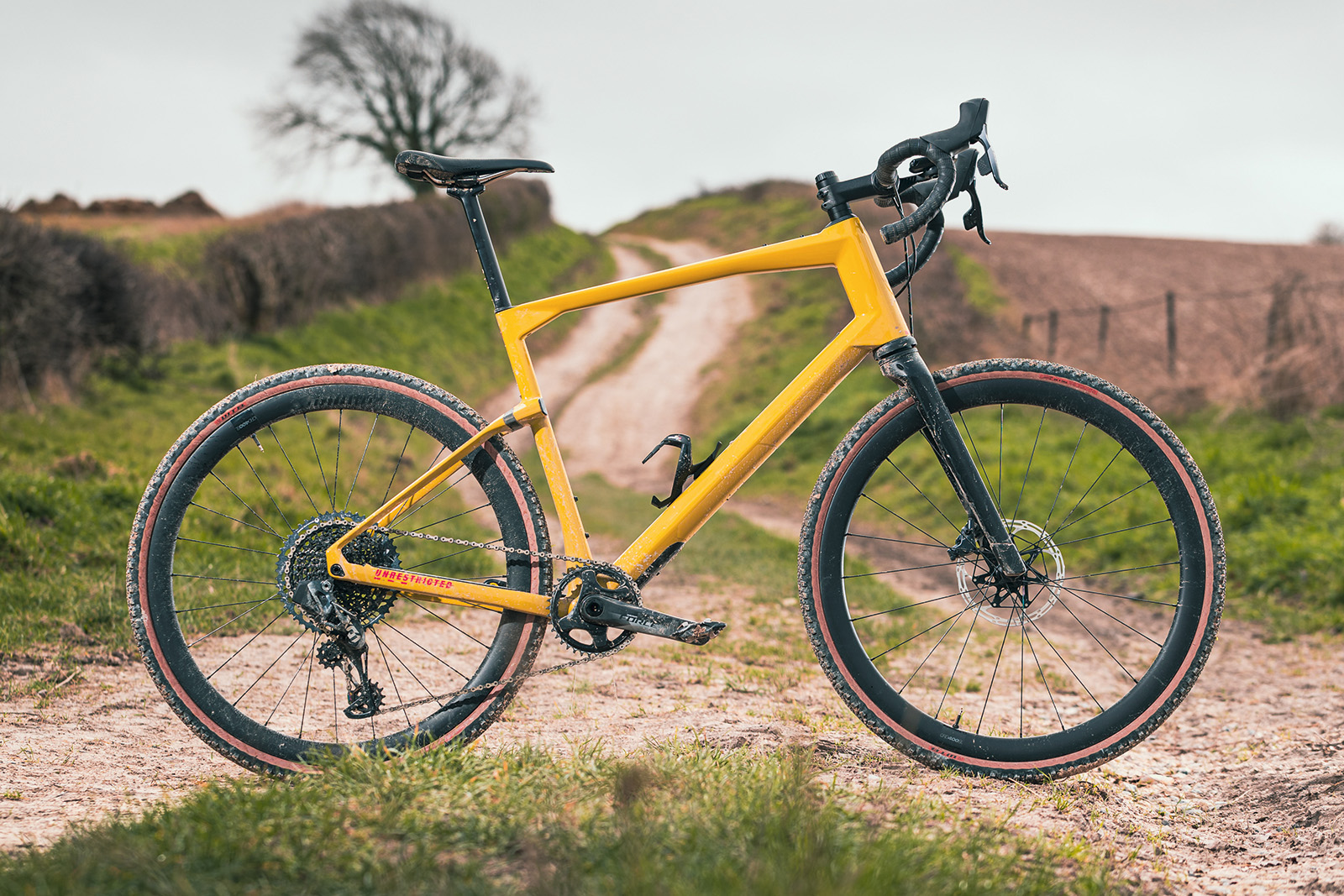
- £7,600 / $8,000 / €8,000 as tested
- Pros: Built-in suspension; lively, controlled ride; fast and smooth
- Cons: Stiff saddle; low-spec bar
The BMC URS includes the brand’s MTT 10mm-travel micro-suspension system at the rear, which builds an elastomer block into the seatstays. That’s matched with a tuneable 20mm-travel fork for a comfortable, efficient ride on rougher gravel.
The geometry includes a slack 70-degree head angle for controlled steering, but a steep 74-degree seat tube that places you right over the pedals. The carbon layup is designed to make the frame yet smoother but still efficient.
There’s great ride quality for fast gravel riding on rattly surfaces and the 9.9kg weight is respectable for an XL-size gravel bike.
The spec includes a mullet Force/X01 Eagle AXS drivetrain and BMC CRD 400 carbon wheels with 40mm WTB Raddler tyres, all making for efficient progress.
Cannondale Topstone Carbon Rival AXS
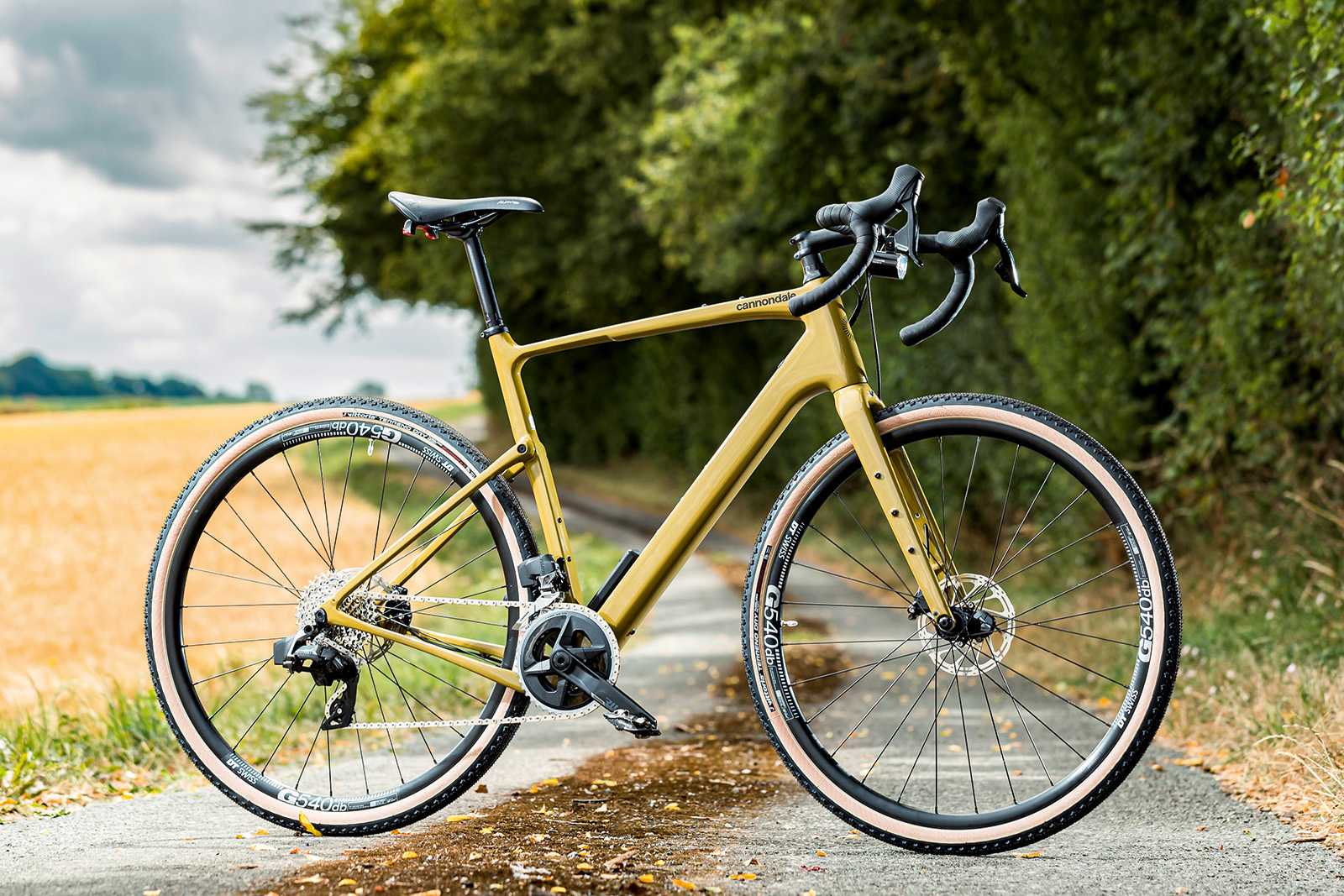
- £4,850 as tested
- Pros: Fun, inspiring handling; Cannondale’s Kingpin suspension; integrated lights
- Cons: Lights aren’t that powerful
The Cannondale Topstone Carbon Rival ACS is a go-anywhere gravel bike that can take on technical, off-road terrain but feels like a cruising, endurance road bike.
Cannondale’s Kingpin suspension, which is built into where the seatstays meet the down tube, creates a plush, comfortable ride.
The choice of a 2x SRAM Rival AXS groupset might seem unconventional for an up-to-date gravel bike, but it performs superbly.
The gravel wheels are made by DT Swiss and are shod with Vittoria Terreno Dry tyres, which provide good bite in dry conditions.
Cannondale has specced the bike with integrated lights, which are convenient but might not be powerful enough for off-road night riding.
Canyon Grail CF SL 7.0
- Buy now from Canyon

- £2,649 / $2,699 as tested
- Pros: Superb kit for the cash; unique cockpit
- Cons: Handlebar can be hard to adjust
The carbon Canyon Grail bikes all come with Canyon’s unusual double-decker Hover bar, now rebranded the Canyon CP07 Gravelcockpit CF. We preferred the old name.
Although it looks a bit odd, this gravel handlebar is a clever way to add front-end compliance without the weight of a suspension fork or other active system.
The Grail is Canyon’s racier gravel bike and doesn’t have the tyre clearance of the Grizl. But that does make it a fast ride both off-road and on. The spec of this most affordable carbon Grail is superb for the price, with a Shimano GRX groupset and DT Swiss wheels.
If you fancy a higher spec, we’ve also ridden the fancier Canyon Grail CF8.0 SL eTap with an electronic groupset.
Cervélo Áspero Rival XPLR eTap AXS 1 Disc

- £5,500 / $5,500 / €5,700 as tested
- Pros: Lightweight, agile and fast; consistent handling on 700c and 650b wheels; quality spec
- Cons: Needs to be set up tubeless for best performance
The Cervélo Áspero is a bike designed around fast gravel riding and gravel racing. There’s now a higher-spec Áspero 5 with an even more racey design, including a one-piece bar/stem and aero seatpost, but we reviewed the lower spec with external cable routing and a separate bar and stem.
The Áspero’s fork comes with an adjustable dropout so you can change the geometry for consistent handling whether you choose to run 650b or 700c wheels.
It’s a stiff, responsive, fast ride both on gravel and on tarmac. The quality spec of the test bike included Reserve carbon wheels and a SRAM Rival AXS XPLR groupset.
Cube Nuroad C:62 Pro
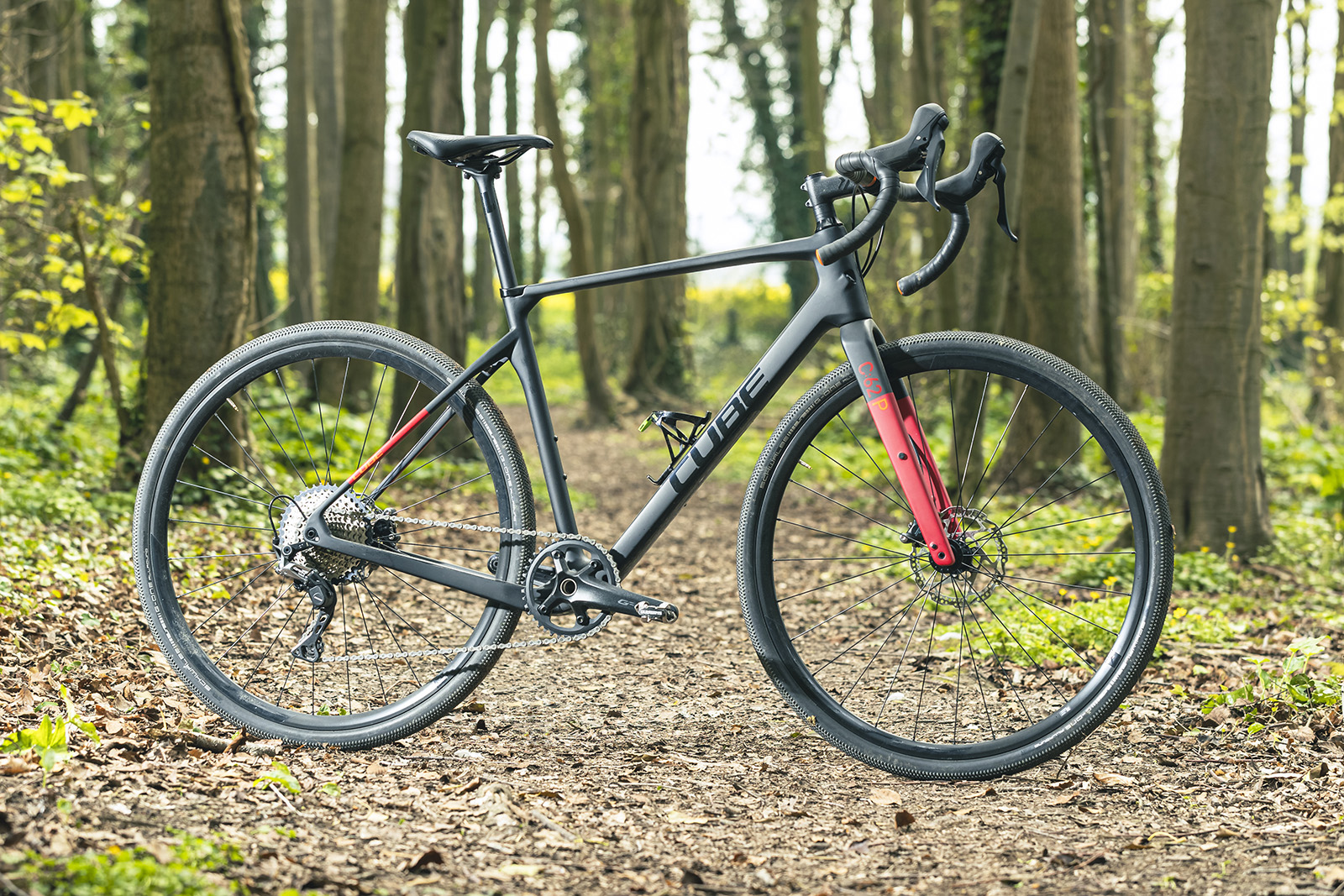
- £2,499 / $2,400 / €2,199 as tested
- Pros: Versatile geometry works well on road and off; Mixed Shimano GRX spec works well
- Cons: Stiff bar offsets comfortable saddle
The Cube Nuroad is an all-road style bike that, as well as serving gravel duties, can be set up with front and rear racks and mudguards for touring or commuting.
Cube even includes a mounting point for a kickstand. You don’t get the extra bottle and bag mounts that many gravel bikes offer though, just the usual two bottle cage mounts as found on road bikes.
The geometry too isn’t out-and-out gravel and is closer to an endurance bike. That makes it good for road riding, which is helped by the comfortable saddle. However, the handlebar isn’t quite up to the job off-road, feeling harsh and like a compromise too far.
ENVE MOG (Shimano GRX Di2)
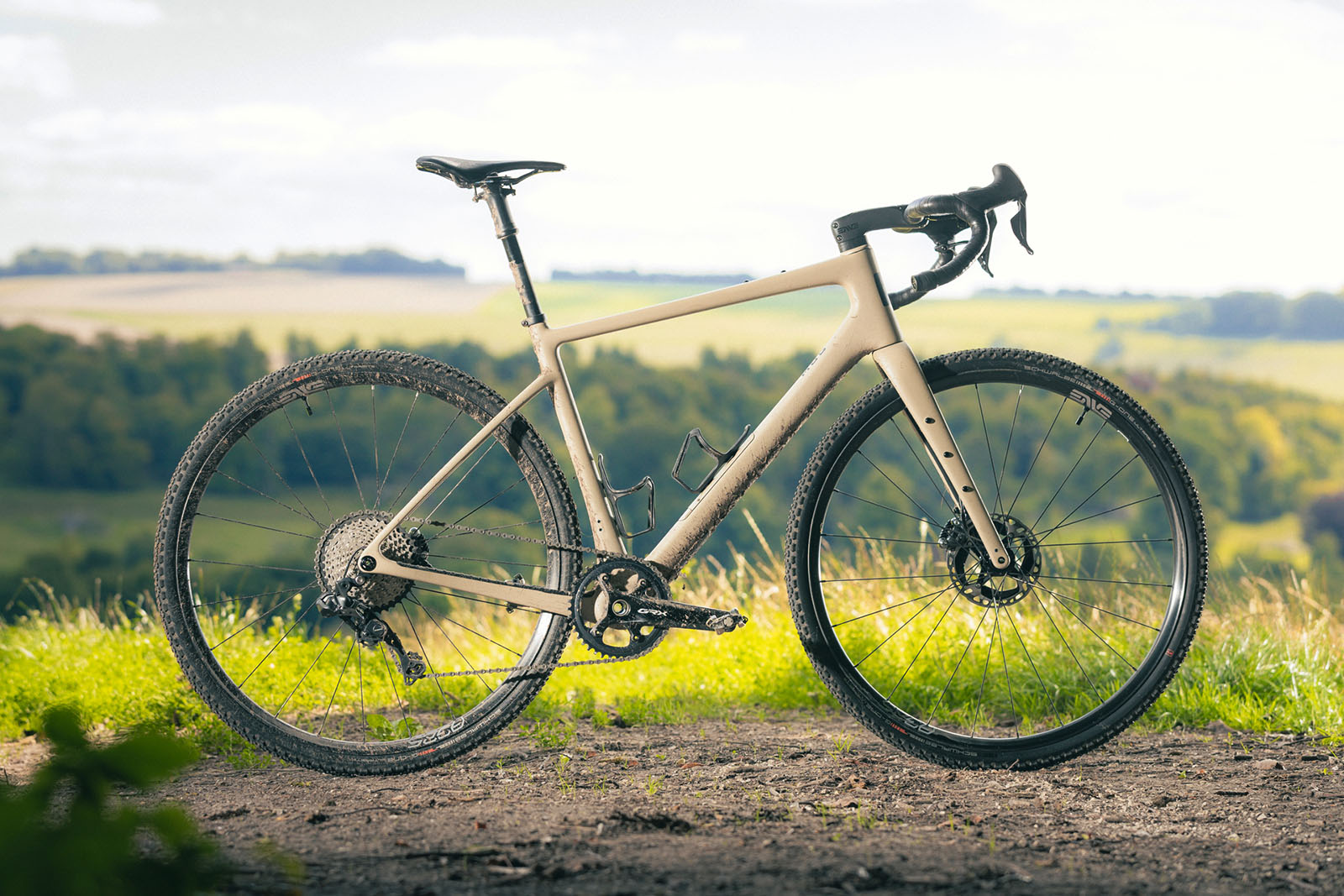
- £10,500 as tested
- Pros: Nimble with capable handling; feels fast
- Cons: High price; no off-the-peg builds
The ENVE MOG is well-suited to rough terrain, feeling composed on technical trails and with its generous 700x50mm soaking up the bumps. The build we tested even has a dropper post.
However, the bike is no slouch, either. It proves to be fast and nimble on smoother gravel tracks, creating a versatile all-rounder.
The performance is enticing and our reviewer described the MOG as one of the most impressive gravel bikes going. But the price tag also makes it one of the most expensive.
Focus Atlas 8.9
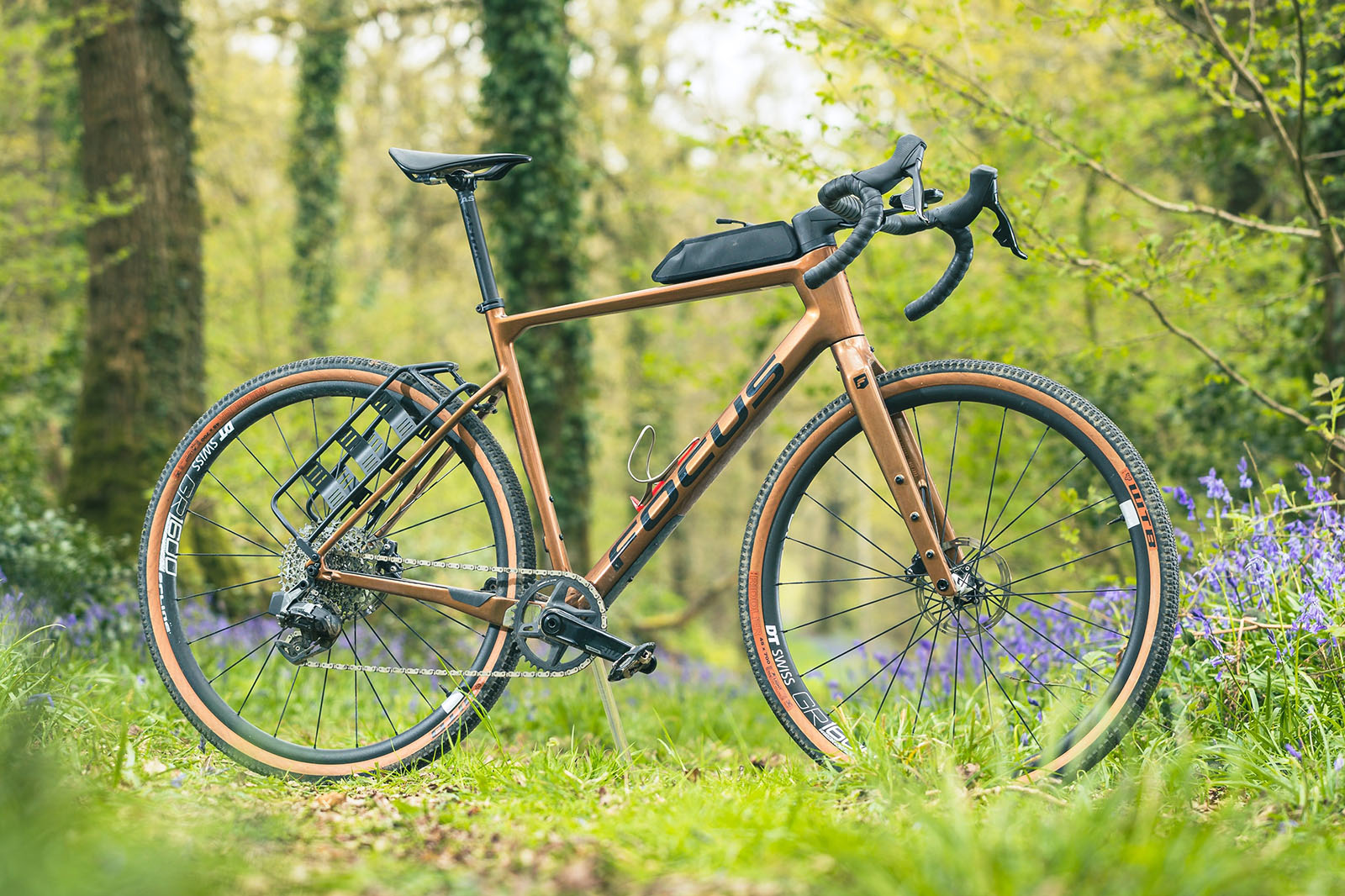
- £4,199 / $4,299 as tested
- Pros: Great build; low weight; balanced handling
- Cons: Frame and fork are stiff; bottom bracket on our test bike developed a creak
The Atlas is all about big bikepacking adventures, and to this end, Focus has even designed specific accessories and racks to maximise the bike’s load-carrying potential.
The bike’s handling is composed and the relaxed head angle helps the Atlas roll straight over the worst surfaces. A go-far bike like this could miss some ride excitement, but Focus has ensured the Atlas is fun to ride and it can still take on twisting singletrack or rougher downhills.
The frame is firm, but the 700x45mm gravel tyres soften the ride.
Overall, the Focus Atlas is a bit of a chameleon. This will be ideal for some but might be a drawback for others.
Juliana Quincy CC Rival

- £3,699 / $3,699 / €3,899 as tested
- Pros: Multi-discipline capability; generous tyre clearance; mudguard mounts; stunning looks
- Cons: Pricey; brakes lacking in power
From Santa Cruz’s women’s-specific brand, the Juliana Quincy is a women’s version of the Santa Cruz Stigmata. It has the same frame, but women’s-specific component choice and clearance for 45mm tyres on 700c rims of 2.1in on 650b wheels.
We found the bike’s versatility appealing. It’s good for gravel, easier off-road and bikepacking as well as being comfortable and engaging for long road rides, with a comfortable frame and fork.
The SRAM Rival 1 11-speed groupset does the job, although the disc brake rotors let the side down on longer technical descents.
Pinarello Grevil F

- £5,300 / $6,500 / €6,100 as tested
- Pros: Race-specific geometry and spec; stable at speed; low-spec wheels for the price
- Cons: Relatively heavy; low-spec wheels for the price
The Pinarello Grevil F shares many of the design features of the Pinarello Dogma F ridden by Team Ineos, with a similar asymmetric frame and fork, and a geometry designed for gravel racing rather than more technical riding.
It’s stiff and aero too, really enabling you to put the power down on flatter off-road. As with the Dogma F, components including the one-piece cockpit with integrated cabling come from Pinarello’s Most parts brand.
Pinarello has squeezed plenty of tyre clearance into the frame, with room for 50mm tyres thanks to the dropped chainstay design. The ride feels stable for a racier gravel bike.
Our Campagnolo Ekar equipped spec offered plenty of gear range from its 13-speed cassette and the brand’s impressive disc braking, although we found the thumb levers awkward to reach. The alloy wheelset needs an upgrade to match the rest of the spec though.
Pivot Vault

- £8,000 / $6,700 / €7,600 as tested
- Impressive on fast gravel as well as more technical ground
- Vibration-damping seatpost design works well
- Under-specced for the price
Whereas Pinarello comes from a road background, Pivot’s starting point is mountain bikes. The Vault was introduced in 2013 and this is its fourth iteration with 700c x 47mm or 650b x 2in clearance.
It also includes Pivot’s IsoFlex, which sandwiches an elastomer insert in the seat tube/seatpost junction to add comfort. It comes in two thicknesses, to enable you to fit a 30.9mm dropper post or a 27.2mm standard seatpost.
The IsoFlex seatpost design works really well and helps smooth out bumpier terrain. Pivot’s MTB background stand out on more technical ground though, with controlled descents and easy climbing.
We were less impressed by the component spec, which feels low-grade for an expensive bike. The choice of Ultegra over GRX feels like a mis-step too and leads to excess chain slap and chatter.
Salsa Warbird C GRX 600 v4

- £3,300 / $3,500 as tested
- Sharp handling
- Many mounting points for bags
- Well thought-out spec
Salsa is on its fourth iteration of the Warbird, which was one of the first gravel-oriented drop-bar bikes built to race. However, 10 years later it’s morphed into more of an all-rounder gravel bike with 45c x 700c or 2.1in x 650b tyre clearance and an excess of mounting points to increase versatility.
This base model has a Shimano GRX RX600 groupset, alloy WTB rims in Shimano hubs and Teravail Cannonball 42mm tyres.
We loved the shape, reach and drop of the Salsa Cowbell bars and, despite what the geometry figures suggest, its balanced ride both off-road and on.
Scott Addict Gravel 30

- £2,600 / $3,000 / €3,000 / AU$4,500 as tested
- Racy position and fast ride
- Aero tube profiles borrowed from the Addict RC road bike
- A few spec upgrades would improve the ride experience
The Scott Addict Gravel borrows features from the Addict RC pro-level race bike, including its aero frame profiles and front-end integration. Geometry-wise, it’s fast and low, but still allows you to fit 45mm tyres and the 9.4kg weight helps add to the racey qualities.
It’s a bike that feels very fast on less techy gravel and balanced when things get more tricky, although the ride position isn’t ideal for twisty singletrack. It’s fast on tarmac as well.
At 30-spec level, there’s a 2x Shimano GRX RX600 groupset and a rather heavy Syncros RP2.0 wheelset. These would benefit from an upgrade to shed some weight. The aero seatpost prevents you fitting a dropper post and a wider-nosed saddle would better suit the ride position.
Specialized S-Works Crux

- £11,300 / $12,250 / €12,500 / AU$18,000 as tested
- Top-tier ride experience
- Among the lightest gravel framesets
- Big tyre clearance (up to 2.1in with 650b wheels)
Formerly a cyclocross rig, the Crux is now a fast gravel bike that can take on ‘cross in its spare time. It’s super-light, with a stiff 750g frameset and aggressive fast gravel geometry, which leads to a racey ride, although it’s not as competent on rougher gravel and techy descents as more planted gravel bikes. You can add comfort by fitting 650b wheels with tyres up to 2.1in.
It’s super-expensive and pared down, so if you want bag and mudguards mounts, look elsewhere.
Likewise, if you want a cabled front derailleur, because there’s no routing, although wireless or 1x are just fine. The 7.3kg weight makes it one of the lightest gravel bikes out there though.
Specialized Diverge Comp Carbon

- £4,000 / $3,900 / €4,499 / AU$6,000 as tested
- Future Shock 2.0 suspension
- SWAT storage box
- Fun yet composed ride character
- 700×47mm/650×54mm tyre clearance
Specialized adds 20mm of front-end comfort to the Diverge with its simple, tuneable Future Shock 2.0 suspension system. There’s plenty of rear-end comfort too, although you can add even more compliance with the Diverge STR – see below.
The Diverge can handle racing as well as it can bikepacking. It’s composed whether riding fast or steep technical descents and the SWAT box enables you to hide stuff in the frame.
The Comp Carbon balances performance and value well, although the Diverge is pricey relative to some of the competition.
There’s a decent spec, including a Shimano GRX RX810 mechanical groupset and Specialized’s Adventure Gear Hover bar, although we’d swap out the 38mm tyres for anything but the driest riding. There’s room for 47mm x 700c or 2.1in x 650b.
Specialized Diverge STR Expert
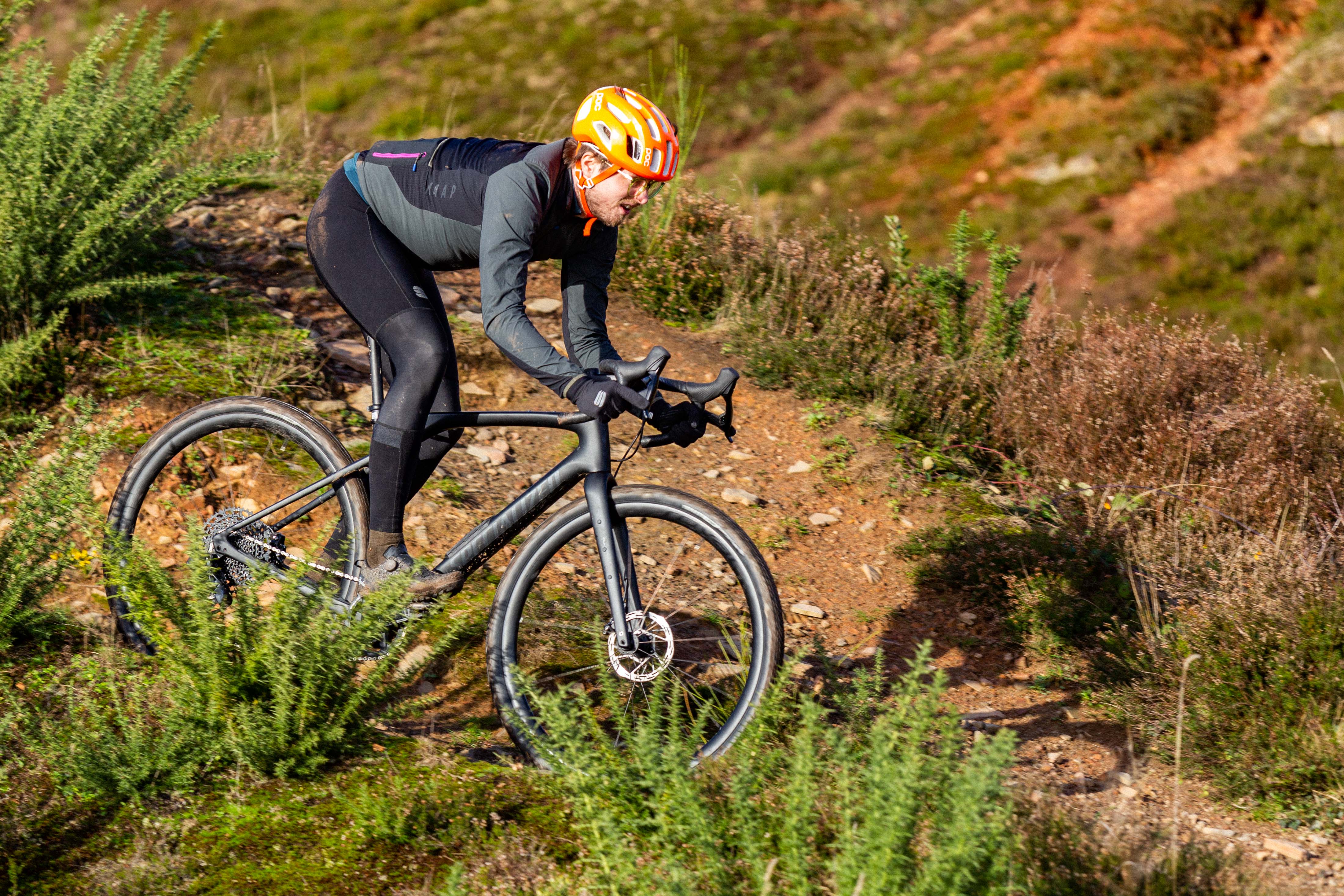
- £7,500 / $7,500 / €7,550 as tested
- Plush riding in the saddle
- All-round capability
- Mixed spec
Not content with the standard Diverge’s front Future Shock 2.0, Specialized added Future Shock Rear suspension to the Diverge STR. Essentially, the seat tube hangs off the back of the top tube, with a damper holding the two together. It’s a slightly fiddly process to set up and tune, but works well once sorted.
As with the standard Diverge, the Diverge STR handles a wide range of gravel riding from the fast to the techy. VFM isn’t the best though, thanks to the complex frame.
The SRAM Rival/GX Eagle AXS drivetrain feels out of place on a bike of this price, although the wide Roval Terra C carbon wheels go some way towards making up for this.
Vitus Substance CRX

- £2,300 / $3,000 / €2,700 / AU$4,000 as tested
- Lightweight carbon wheelset
- True mountain bike character
- Exceptional value
- 650b × 47mm tyre clearance
Vitus offers a range of bikes well tuned to their various uses and the Substance is no exception, with a great choice of geometry, drivetrain and components for the price and a sub-9kg weight in size XL. Mounts include Anything bolts on the fork legs if you want to load up.
The spec includes mechanical 11-speed SRAM Rival 1, carbon Prime 650b wheels and 47mm WTB Venture tyres. There’s a lot of versatility built in, so you could set up for commutes, bikepacking or just making use of the sorted ride to blast around in the woods.
Buyer’s guide to carbon gravel bikes
What types of carbon gravel bikes are there?

More than any other material, carbon gravel bikes illustrate the diverse uses for which the best gravel bikes can be designed.
There’s still a wide range of all-rounder gravel bikes, typified by the Boardman ADV 9.0 and Cannondale Topstone, that can tackle anything reasonably well. But increasingly, gravel bikes are dividing into clans.
At one end are gravel race bikes. Driven by the ever-increasing popularity of gravel racing, these are bikes designed to travel fast and light off-road. They often include aero features and have geometries that allow you to ride faster, often with more limited tyre clearance. They’re typified by the Pinarello Grevil F, Scott Addict Gravel and several other bikes above.

At the other end of the spectrum are gravel bikes designed for more technical riding. These have big tyre clearance, often run on 650b wheels, have sub-1:1 gearing and may include a dropper post and a suspension fork.
The Giant Revolt X is a good example. Based on the Giant Revolt all-rounder, the Revolt X’s added features incline it much more towards technical riding.
Yet another category of gravel bikes is geared towards bikepacking and multi-day off-road adventures. As with the more technical gravel bikes, they often include 650b wheels and wide tyres, to provide a comfortable ride when loaded up and very low gearing to help carry the extra weight up hills.
The Salsa Warbird and Vitus Substance CRX are examples above that cater well for this style of riding.
What are the advantages of carbon gravel bikes?
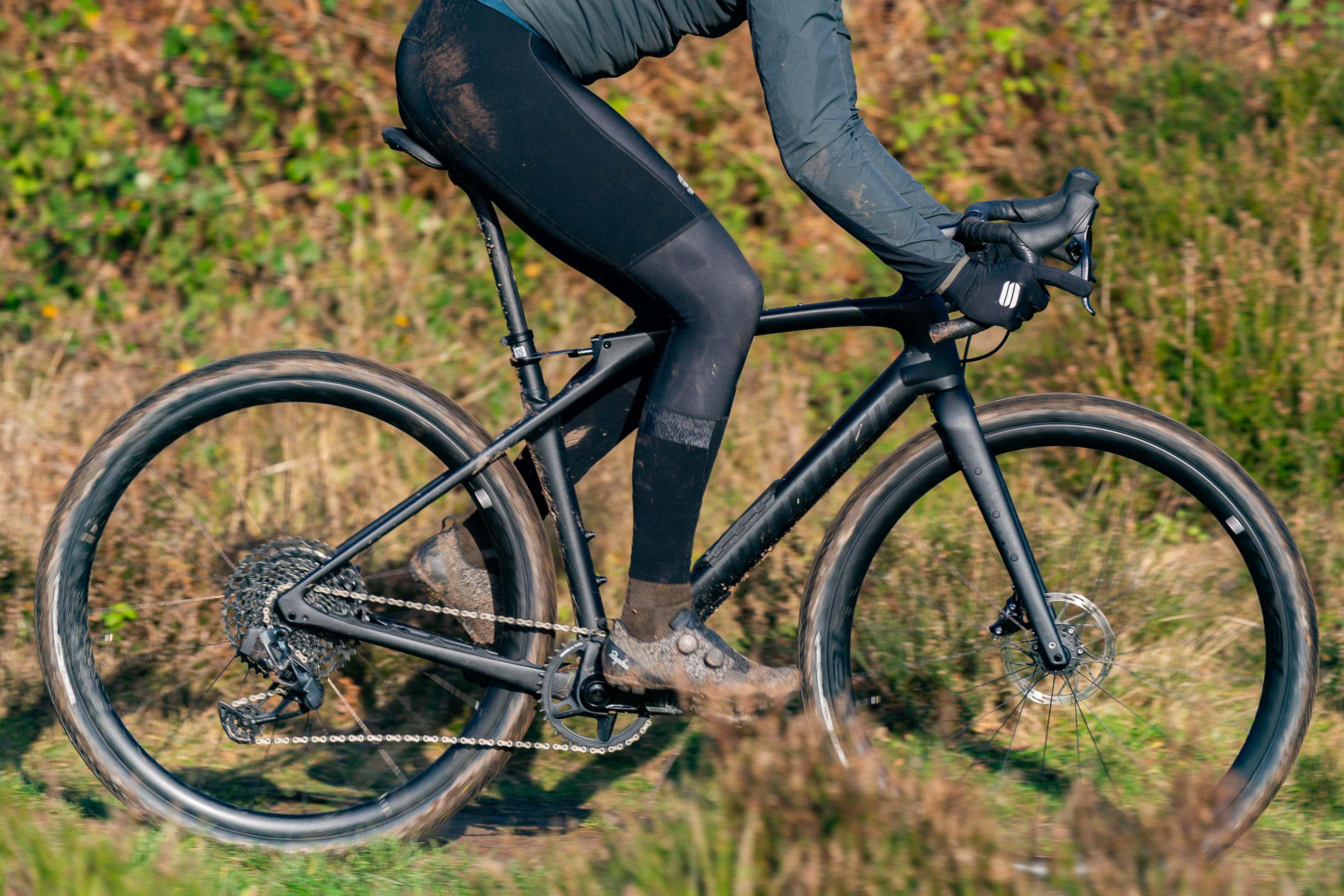
One of the main advantages of carbon gravel bikes over gravel bikes made of other materials is the ability to make them lightweight and compliant, while still stiff enough to pedal efficiently.
Carbon fibre lends itself to the construction of bikes with tuned ride characteristics, as the carbon layup can be adjusted to provide flex or vibration absorption where it’s needed, but stiffness where it aids efficient progress.
Often a standard frame design caters for this. However, in bikes such as the Cannondale Topstone Carbon and the Specialized Diverge STR, there are more active suspension elements built in that take advantage of carbon fibre’s ability to flex under load without needing the hinges that feature in mountain bike suspension. This saves significant weight.
Are carbon gravel bikes strong enough for off-road riding?

There was understandable initial caution about using carbon fibre for off-road applications. This was even more pronounced in the mountain bike market than for gravel bikes and it’s only in the last few years that carbon-framed MTBs have become prevalent.
However, manufacturers have learned where to strengthen bikes for off-road riding, adding more carbon fibre in areas more prone to damage, such as the underside of the down tube. Some brands, such as BMC, add extra frame protection to these areas.
Although carbon gravel bikes are strengthened against impact damage, it’s still possible to write off a carbon gravel bike frame in a heavy crash, usually due to delamination of the carbon layers.
How do carbon gravel bikes compare to aluminium gravel bikes?

It’s a generalisation, but in general, carbon gravel bikes are lighter and more compliant than aluminium gravel bikes, leading to a better ride quality. They’re also usually more expensive, as carbon fibre construction is more labour-intensive than welding alloy frames and the raw materials are more expensive too.
Carbon fibre tends to be used for more specialist designs, whereas aluminium gravel bikes are often lower-priced all-rounders.
What about carbon gravel bikes vs titanium gravel bikes?
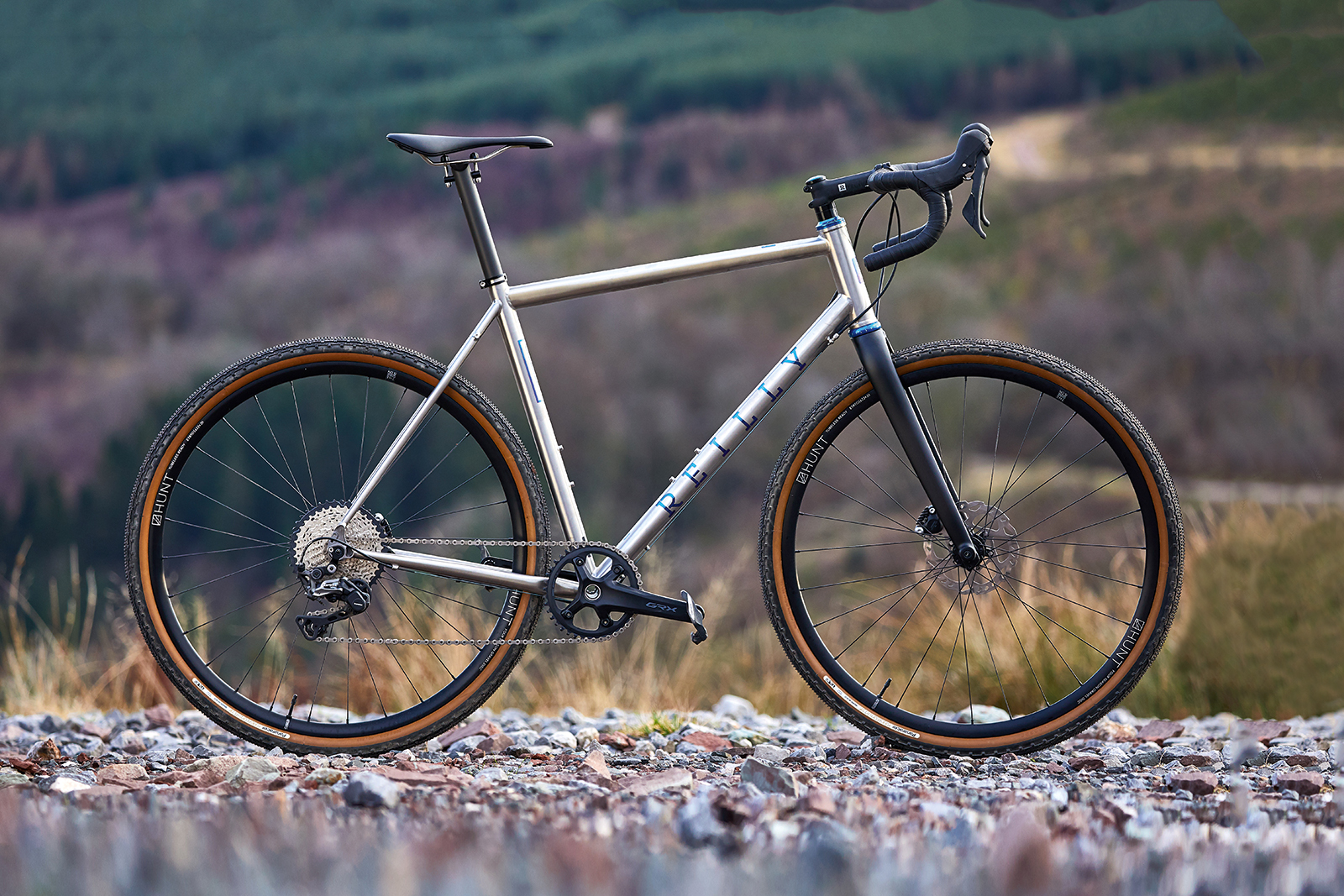
The price differential between carbon gravel bikes and titanium gravel bikes is less than between carbon and aluminium, and many carbon gravel bikes will undercut the price of titanium gravel bikes. That’s because titanium is an expensive metal both to buy and to manufacture cycle frames from.
There are fewer titanium gravel bike models produced than carbon ones and they often come from titanium specialists, while pretty much every brand that sells carbon bikes will have a carbon gravel bike in its range.
The smaller market volumes mean titanium gravel bikes tend to be all-rounders rather than specialist designs.
Titanium gravel bikes, in general, have a reputation for ride comfort, because titanium, rather like steel, will flex a little under load and damp out vibrations from the surface.
Titanium doesn’t rust and the raw metal finish of many titanium gravel bikes is aesthetically appealing. It also has high fatigue resistance and can withstand bashes better than aluminium, carbon or steel gravel bikes.